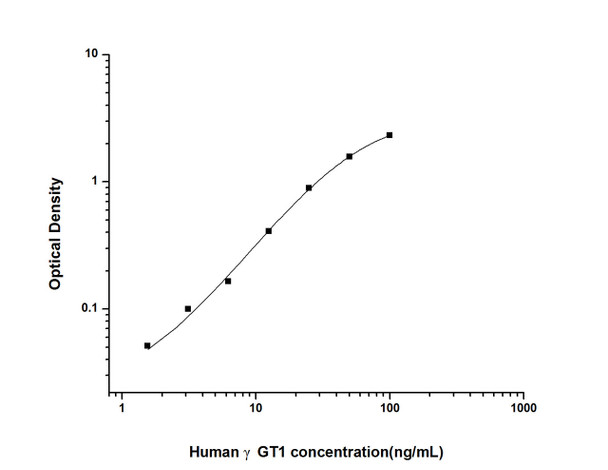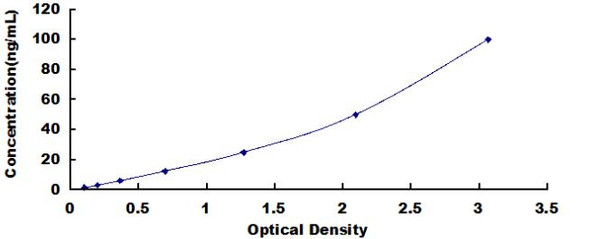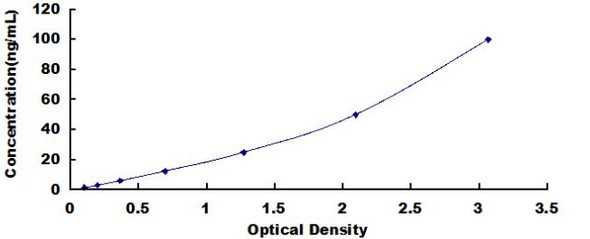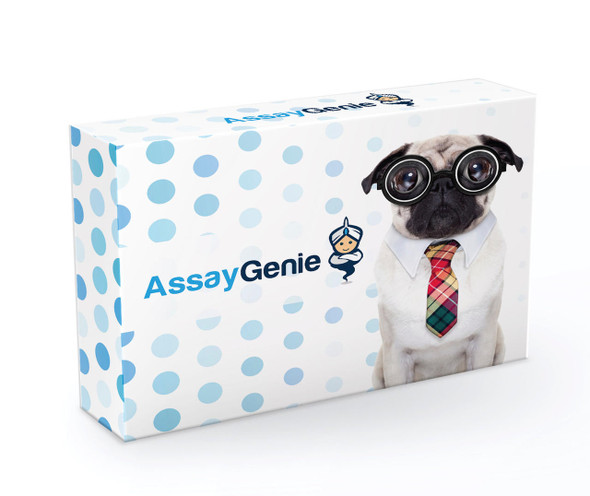Human Metabolism ELISA Kits
Human gammaGT1 (Gamma Glutamyltransferase 1) ELISA Kit (HUES02119)
- SKU:
- HUES02119
- Product Type:
- ELISA Kit
- Size:
- 96 Assays
- Uniprot:
- P19440
- Sensitivity:
- 0.94ng/mL
- Range:
- 1.56-100ng/mL
- ELISA Type:
- Sandwich
- Synonyms:
- GGT1, CD224, D22S672, D22S732, G-GT1, GTG, gamma-glutamyl transpeptidase, GGTP, gamma-GT
- Reactivity:
- Human
- Sample Type:
- Serum, plasma and other biological fluids
- Research Area:
- Metabolism
Description
| Assay type: | Sandwich |
| Format: | 96T |
| Assay time: | 4.5h |
| Reactivity: | Human |
| Detection Method: | Colormetric |
| Detection Range: | 1.56-100 ng/mL |
| Sensitivity: | 0.94 ng/mL |
| Sample Volume Required Per Well: | 100µL |
| Sample Type: | Serum, plasma and other biological fluids |
| Specificity: | This kit recognizes Human gammaGT1 in samples. No significant cross-reactivity or interference between Human gammaGT1 and analogues was observed. |
This ELISA kit uses Sandwich-ELISA as the method. The micro ELISA plate provided in this kit has been pre-coated with an antibody specific to Human gammaGT1. Standards or samples are added to the appropriate micro ELISA plate wells and combined with the specific antibody. Then a biotinylated detection antibody specific for Human gammaGT1 and Avidin-Horseradish Peroxidase (HRP) conjugate are added to each micro plate well successively and incubated. Free components are washed away. The substrate solution is added to each well. Only those wells that contain Human gammaGT1, biotinylated detection antibody and Avidin-HRP conjugate will appear blue in color. The enzyme-substrate reaction is terminated by adding Stop Solution and the color turns yellow. The optical density (OD) is measured spectrophotometrically at a wavelength of 450 nm ± 2 nm. The OD value is proportional to the concentration of Human gammaGT1. The concentration of Human gammaGT1 in samples can be calculated by comparing the OD of the samples to the standard curve.
| UniProt Protein Function: | GGT1: Initiates extracellular glutathione (GSH) breakdown, provides cells with a local cysteine supply and contributes to maintain intracellular GSH level. It is part of the cell antioxidant defense mechanism. Catalyzes the transfer of the glutamyl moiety of glutathione to amino acids and dipeptide acceptors. Alternatively, glutathione can be hydrolyzed to give Cys-Gly and gamma glutamate. Isoform 3 seems to be inactive. Defects in GGT1 are a cause of glutathionuria (GLUTH); also known as gamma-glutamyltranspeptidase deficiency. It is an autosomal recessive disease. Belongs to the gamma-glutamyltransferase family. 3 isoforms of the human protein are produced by alternative promoter. |
| UniProt Protein Details: | Protein type:Other Amino Acids Metabolism - taurine and hypotaurine; Membrane protein, integral; Other Amino Acids Metabolism - glutathione; EC 3. 4. 19. 13; EC 3. 4. 19. 14; Transferase; Other Amino Acids Metabolism - cyanoamino acid; Other Amino Acids Metabolism - selenoamino acid; Lipid Metabolism - arachidonic acid; EC 2. 3. 2. 2 Chromosomal Location of Human Ortholog: 22q11. 23 Cellular Component: anchored to external side of plasma membrane; extracellular space; integral to membrane; plasma membrane Molecular Function:protein binding; gamma-glutamyltransferase activity Biological Process: amino acid metabolic process; glutamate metabolic process; regulation of immune system process; cysteine biosynthetic process; leukotriene metabolic process; proteolysis; leukotriene biosynthetic process; glutathione metabolic process; xenobiotic metabolic process; regulation of inflammatory response; glutathione catabolic process; glutathione biosynthetic process; arachidonic acid metabolic process; zymogen activation; spermatogenesis Disease: Glutathionuria |
| NCBI Summary: | The enzyme encoded by this gene is a type I gamma-glutamyltransferase that catalyzes the transfer of the glutamyl moiety of glutathione to a variety of amino acids and dipeptide acceptors. The enzyme is composed of a heavy chain and a light chain, which are derived from a single precursor protein. It is expressed in tissues involved in absorption and secretion and may contribute to the etiology of diabetes and other metabolic disorders. Multiple alternatively spliced variants have been identified. There are a number of related genes present on chromosomes 20 and 22, and putative pseudogenes for this gene on chromosomes 2, 13, and 22. [provided by RefSeq, Jan 2014] |
| UniProt Code: | P19440 |
| NCBI GenInfo Identifier: | 93140064 |
| NCBI Gene ID: | 2678 |
| NCBI Accession: | P19440. 2 |
| UniProt Secondary Accession: | P19440,Q08247, Q14404, Q8TBS1, Q9UMK1, |
| UniProt Related Accession: | P19440 |
| Molecular Weight: | 569 |
| NCBI Full Name: | Gamma-glutamyltranspeptidase 1 |
| NCBI Synonym Full Names: | gamma-glutamyltransferase 1 |
| NCBI Official Symbol: | GGT1 |
| NCBI Official Synonym Symbols: | GGT; GTG; CD224; GGT 1; D22S672; D22S732 |
| NCBI Protein Information: | gamma-glutamyltranspeptidase 1; glutathione hydrolase 1; leukotriene-C4 hydrolase |
| UniProt Protein Name: | Gamma-glutamyltranspeptidase 1 |
| UniProt Synonym Protein Names: | Gamma-glutamyltransferase 1; Glutathione hydrolase 1 (EC:3. 4. 19. 13); Leukotriene-C4 hydrolase (EC:3. 4. 19. 14); CD_antigen: CD224Cleaved into the following 2 chains:Gamma-glutamyltranspeptidase 1 heavy chain; Gamma-glutamyltranspeptidase 1 light chain |
| Protein Family: | Gamma-glutamyltranspeptidase |
| UniProt Gene Name: | GGT1 |
| UniProt Entry Name: | GGT1_HUMAN |
As the OD values of the standard curve may vary according to the conditions of the actual assay performance (e. g. operator, pipetting technique, washing technique or temperature effects), the operator should establish a standard curve for each test. Typical standard curve and data is provided below for reference only.
| Concentration (ng/mL) | O.D | Average | Corrected |
| 100 | 2.356 2.388 | 2.372 | 2.319 |
| 50 | 1.623 1.623 | 1.623 | 1.57 |
| 25 | 0.962 0.928 | 0.945 | 0.892 |
| 12.5 | 0.452 0.47 | 0.461 | 0.408 |
| 6.25 | 0.218 0.218 | 0.218 | 0.165 |
| 3.13 | 0.159 0.147 | 0.153 | 0.1 |
| 1.56 | 0.103 0.105 | 0.104 | 0.051 |
| 0 | 0.052 0.054 | 0.053 | -- |
Precision
Intra-assay Precision (Precision within an assay): 3 samples with low, mid range and high level Human gammaGT1 were tested 20 times on one plate, respectively.
Inter-assay Precision (Precision between assays): 3 samples with low, mid range and high level Human gammaGT1 were tested on 3 different plates, 20 replicates in each plate.
| Intra-assay Precision | Inter-assay Precision | |||||
| Sample | 1 | 2 | 3 | 1 | 2 | 3 |
| n | 20 | 20 | 20 | 20 | 20 | 20 |
| Mean (ng/mL) | 4.64 | 11.93 | 39.33 | 4.90 | 12.50 | 40.75 |
| Standard deviation | 0.27 | 0.66 | 1.38 | 0.30 | 0.63 | 2.01 |
| C V (%) | 5.82 | 5.53 | 3.51 | 6.12 | 5.04 | 4.93 |
Recovery
The recovery of Human gammaGT1 spiked at three different levels in samples throughout the range of the assay was evaluated in various matrices.
| Sample Type | Range (%) | Average Recovery (%) |
| Serum (n=5) | 93-110 | 100 |
| EDTA plasma (n=5) | 89-102 | 95 |
| Cell culture media (n=5) | 91-104 | 98 |
Linearity
Samples were spiked with high concentrations of Human gammaGT1 and diluted with Reference Standard & Sample Diluent to produce samples with values within the range of the assay.
| Serum (n=5) | EDTA plasma (n=5) | Cell culture media (n=5) | ||
| 1:2 | Range (%) | 89-103 | 87-103 | 88-100 |
| Average (%) | 95 | 94 | 94 | |
| 1:4 | Range (%) | 87-99 | 87-100 | 90-100 |
| Average (%) | 94 | 92 | 95 | |
| 1:8 | Range (%) | 88-101 | 86-100 | 83-99 |
| Average (%) | 93 | 92 | 90 | |
| 1:16 | Range (%) | 90-102 | 85-99 | 84-98 |
| Average (%) | 95 | 91 | 90 |
An unopened kit can be stored at 4°C for 1 month. If the kit is not used within 1 month, store the items separately according to the following conditions once the kit is received.
| Item | Specifications | Storage |
| Micro ELISA Plate(Dismountable) | 8 wells ×12 strips | -20°C, 6 months |
| Reference Standard | 2 vials | |
| Concentrated Biotinylated Detection Ab (100×) | 1 vial, 120 µL | |
| Concentrated HRP Conjugate (100×) | 1 vial, 120 µL | -20°C(shading light), 6 months |
| Reference Standard & Sample Diluent | 1 vial, 20 mL | 4°C, 6 months |
| Biotinylated Detection Ab Diluent | 1 vial, 14 mL | |
| HRP Conjugate Diluent | 1 vial, 14 mL | |
| Concentrated Wash Buffer (25×) | 1 vial, 30 mL | |
| Substrate Reagent | 1 vial, 10 mL | 4°C(shading light) |
| Stop Solution | 1 vial, 10 mL | 4°C |
| Plate Sealer | 5 pieces | |
| Product Description | 1 copy | |
| Certificate of Analysis | 1 copy |
- Set standard, test sample and control (zero) wells on the pre-coated plate and record theirpositions. It is recommended to measure each standard and sample in duplicate. Note: addall solutions to the bottom of the plate wells while avoiding contact with the well walls. Ensuresolutions do not foam when adding to the wells.
- Aliquot 100 µL of standard solutions into the standard wells.
- Add 100 µL of Sample / Standard dilution buffer into the control (zero) well.
- Add 100 µL of properly diluted sample (serum, plasma, tissue homogenates and otherbiological fluids) into test sample wells.
- Cover the plate with the sealer provided in the kit and incubate for 90 min at 37 °C.
- Aspirate the liquid from each well, do not wash. Immediately add 100 µL of BiotinylatedDetection Ab working solution to each well. Cover the plate with a plate seal and gently mix. Incubate for 1 hour at 37 °C.
- Aspirate or decant the solution from the plate and add 350 µL of wash buffer to each welland incubate for 1-2 minutes at room temperature. Aspirate the solution from each well andclap the plate on absorbent filter paper to dry. Repeat this process 3 times. Note: a microplatewasher can be used in this step and other wash steps.
- Add 100 µL of HRP Conjugate working solution to each well. Cover with a plate seal andincubate for 30 min at 37 °C.
- Aspirate or decant the solution from each well. Repeat the wash process for five times asconducted in step 7.
- Add 90 µL of Substrate Reagent to each well. Cover with a new plate seal and incubate forapproximately 15 min at 37 °C. Protect the plate from light. Note: the reaction time can beshortened or extended according to the actual color change, but not by more than 30min.
- Add 50 µL of Stop Solution to each well. Note: Adding the stop solution should be done inthe same order as the substrate solution.
- Determine the optical density (OD value) of each well immediately with a microplate readerset at 450 nm.






